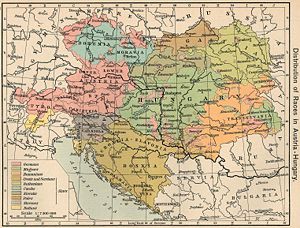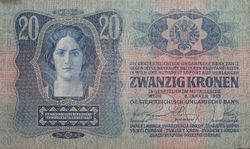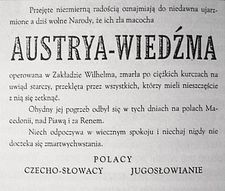Austria-Hungary
2008/9 Schools Wikipedia Selection. Related subjects: General history
|
||||||||||||||||||||||||||||||||||||||||||||||||||||||||||
|
||||||||||||||||||||||||||||||||||||||||||||||||||||||||||
|
||||||||||||||||||||||||||||||||||||||||||||||||||||||||||
|
||||||||||||||||||||||||||||||||||||||||||||||||||||||||||
|
||||||||||||||||||||||||||||||||||||||||||||||||||||||||||
The Austro-Hungarian Empire, also known as Austria-Hungary, the Dual Monarchy or k.u.k. Monarchy or Dual State, was a dual-monarchic union state in Central Europe from 1867 to 1918, dissolved at the end of World War I.
The dual monarchy was the successor to the Austrian Empire (1804–1867) on the same territory, originating in the Austro-Hungarian Compromise of 1867 between the ruling Habsburg dynasty and the Hungarians.
As a multi-national empire and great power in an era of national awakening, it found its political life dominated by disputes among the eleven principal national groups.
Its economic and social life was marked by a rapid economic growth through the age of industrialization and social modernization through many liberal and democratic reforms.
The Habsburg dynasty ruled as Emperors of Austria over the western and northern half of the country and as Kings of Hungary over the Kingdom of Hungary which enjoyed some degree of self-government and representation in joint affairs (principally foreign relations and defence).
The Monarchy bore the full name internationally of "The Kingdoms and Lands Represented in the Imperial Council and the Lands of the Crown of St. Stephen".
The capital of the state was Vienna. The Austro-Hungarian Empire was geographically the second largest country in Europe after the Russian Empire, and the third most populous (after both Russia and the German Empire). Today, the territory it covered has a population of about 73 million.
Names of the Empire in languages officially recognized by the Austro-Hungarian Empire:
- German: Österreich-Ungarn
- Hungarian: Osztrák–Magyar Monarchia
- Czech: Rakousko-Uhersko
- Italian: Austria-Ungheria
- Polish: Austro-Węgry
- Bosnian: Austro-Ugarska
- Romanian: Austro-Ungaria
- Slovak: Rakúsko-Uhorsko
- Slovene: Avstro-Ogrska
- Serbian: Aустро-Угарска, Austro-Ugarska
- Croatian: Austro-Ugarska
- Ukrainian: Австро-Угорщина
- Rusyn: Австро-Магярщина
Creation of the Austro-Hungarian Empire
Austro-Hungarian Compromise of 1867 which inaugurated the Empire's dualist structure in place of the former unitary Austrian Empire (1804–67) originated at a time when Austria had declined in strength and in power — both in the Italian Peninsula (as a result of the Austro–Sardinian War of 1859) and among the states of the German Confederation (where it had been replaced by Prussia as the dominant German-speaking power following the Austro–Prussian War of 1866). Other factors in the constitutional changes included continued Hungarian dissatisfaction with rule from Vienna and increasing national consciousness on the part of other nationalities of the Austrian Empire. Hungarian dissatisfaction grew partially from Austria's suppression, with Russian support, of the Hungarian liberal revolution of 1848–49. However, dissatisfaction with Austrian rule had grown for many years within Hungary, and had many other causes.
In the effort to shore up support for the monarchy, Emperor Franz Joseph began negotiations for a compromise with the Hungarian nobility to ensure their support. In particular, Magyar leaders demanded and received the Emperor's coronation as King of Hungary, and the establishment of a separate parliament at Budapest with the powers to enact laws for the lands of the Hungarian crown (the lands of St. Stephen), which would preserve the political dominance of the Hungarian nobility.
Governmental structure
Three distinct elements ruled The Austro-Hungarian Empire:
- the Hungarian government
- the "Austrian" or Cisleithanian government
- common foreign and military policy under the monarch
Hungary and Austria maintained separate parliaments, each with its own prime minister. Linking/co-ordinating the two fell to a government under a monarch, wielding power absolute in theory but limited in practice. The monarch’s common government had responsibility for the army, for the navy, for foreign policy, and for the customs union.
Within Cisleithania and Hungary certain regions, such as Galicia and Croatia enjoyed special status with their own unique governmental structures.
A common Ministerial Council ruled the common government: it comprised the three ministers for the joint responsibilities (joint finance, military, and foreign policy), the two prime ministers, some Archdukes and the monarch. Two delegations of representatives, one each from the Austrian and Hungarian parliaments, met separately and voted on the expenditures of the Common Ministerial Council, giving the two governments influence in the common administration. However, the ministers ultimately answered only to the monarch, and he had the final decision on matters of foreign and military policy.
Overlapping responsibilities between the joint ministries and the ministries of the two halves caused friction and inefficiencies. The armed forces suffered particularly from overlap. Although the unified government determined overall military direction, the Austrian and Hungarian governments each remained in charge of "the quota of recruits, legislation concerning compulsory military service, transfer and provision of the armed forces, and regulation of the civic, non-military affairs of members of the armed forces". Needless to say, each government could have a strong influence over common governmental responsibilities. Each half of the Dual Monarchy proved quite prepared to disrupt common operations to advance its own interests.
Relations over the half-century after 1867 between the two halves of the Empire (in fact the Cisleithan part contained about 57% of the combined realm's population and a rather larger share of its economic resources) featured repeated disputes over shared external tariff arrangements and over the financial contribution of each government to the common treasury. Under the terms of the Austro-Hungarian Compromise of 1867, an agreement, renegotiated every ten years, determined these matters. Each build-up to the renewal of the agreement saw political turmoil. The disputes between the halves of the empire culminated in the mid-1900s in a prolonged constitutional crisis — triggered by disagreement over the language of command in Hungarian army units, and deepened by the advent to power in Budapest (April 1906) of a Hungarian nationalist coalition. Provisional renewals of the common arrangements occurred in October 1907 and in November 1917 on the basis of the status quo.
Ethnic relations
Article 19 of the Austro-Hungarian constitution stated:
- All races of the empire have equal rights, and every race has an inviolable right to the preservation and use of its own nationality and language. The equality of all customary languages ("landesübliche Sprache") in school, office and public life, is recognized by the state. In those territories in which several races dwell, the public and educational institutions are to be so arranged that, without applying compulsion to learn a second country language ("Landessprache"), each of the races receives the necessary means of education in its own language.
The implementation of this principle led to several disputes since everything depended on the decision as to which language could be regarded as landesüblich or customary. The Germans, the traditional bureaucratic, capitalist and cultural elite, demanded the recognition of their language as a customary language in every part of the empire. While Italian was regarded as an old "culture language" (Kultursprache) by German-speaking intellectuals and had always been granted equal rights as an official language of the Empire, they had particular difficulties in accepting the Slavic languages as equal to German. On one occasion Count A. Auersperg (Anastasius Grün) entered the diet of Carniola carrying what he claimed to be the whole corpus of Slovenian literature under his arm to provide evidence that the Slovenian language could in his view not be substituted for German as a medium of higher education.
Nevertheless the following years saw an emancipation of several languages at least in the Cisleithanian part of the Empire. In a series of laws from 1867 and onwards, the Croatian language was raised to equality with the hitherto officially dominating Italian language in Dalmatia. From 1882 there was a Slovenian majority in the diet of Carniola and in the capital Laibach (Ljubljana), thereby replacing German as the dominant official language. Polish was introduced instead of German in 1869 in Galicia as the normal language of government. The Poles themselves systematically disregarded the large Ukrainian minority in the country, and Ukrainian was not granted the status of an official language.
The language disputes were most fiercely fought in Bohemia and Moravia where the Czechs wanted to establish their language as the dominating language even in the primarily German-speaking bordering areas of the country (later called the " Sudetenland"). German-speakers lost their majority in the Bohemian diet in 1880 and their dominating position in the cities of Prague and Pilsen (while retaining a slight numerical majority in the city of Brno (Brünn)) and found themselves in an unfamiliar minority position. The old Charles University in Prague hitherto dominated by the German-speakers was divided into a German and a Czech part in 1882.
At the same time, Magyar dominance faced challenges from the local majorities of Romanians in Transylvania and in the eastern Banat, of Slovaks in today's Slovakia, of Croats and Serbs in the crownlands of Croatia and of Dalmatia (today's Croatia), in Bosnia and Herzegovina and in the provinces known as the Vojvodina (today's northern Serbia). The Romanians and the Serbs also looked to union with their fellow-nationalists in the newly-founded states of Romania (1859–78) and Serbia.
Though Hungary's leaders showed on the whole less willingness than their Austrian counterparts to share power with their subject minorities, they granted a large measure of autonomy to the kingdom of Croatia in 1868, parallelling to some extent their own accommodation within the Empire the previous year. Croatia, in spite of nominal autonomy, was in fact an economic and administrative arm of Hungary, which the Croatians resented.
Language was one of the most contentious questions in Austro-Hungarian politics. All governments faced difficult and divisive hurdles in sorting out the languages of government and of instruction. Minorities wanted to ensure the widest possibility for education in their own language as well as in the "dominant" languages of Hungarian and German. On one notable occasion, that of the so-called "Ordinance of April 5, 1897", the Austrian Prime Minister Kasimir Felix Graf Badeni gave Czech equal standing with German in the internal government of Bohemia and also in the primarily German-speaking parts of Bohemia, leading to a crisis because of nationalist German agitation throughout the Empire. In the end Badeni was dismissed.
The Hungarian minority act from 1868 gave the minorities (Slovaks, Romanians, Serbs etc.) individual (and not also community) rights to use their language in offices, schools (although in practice often only in those founded by them and not by the state), at courts and in municipalities (if 20%-s of the deputees demanded it). Although already the act XVII from 1879 prescribed the teaching of the Hungarian language as a school subject, in 1900 there were still 1340 schools among the 3343 non-Hungarians where the teaching of the Hungarian (the official language of the state) was unsuccesful. From Juny 1907 (lex Apponyi) all the public and private schools in Hungary were obliged to teach the Hungarian language in such an extent that after the fourth class the pupils could express them fluently in Hungarian (which was rather impossible by the standards of the time and led to the closing of several minority, mostly Slovak schools, although it was far less violent than the politics of the new-founded states and their strong anti-Hungarian sentiment which was expressed in the banning of Hungarian in schools, municipalities and offices).
It was not rare for the two kingdoms to divide spheres of influence. According to Misha Glenny (The Balkans, 1804–1999), the Austrians responded to Hungarian badgering of Czechs by supporting the Croatian national movement in Zagreb.
Emperor Franz Joseph himself was very well aware that he reigned in a multiethnic country and spoke fluent German, Hungarian, Czech, and, to some degree, also Polish and Italian.
The situation of Jews in the kingdom, who numbered about 2 million in 1914, was ambiguous. Anti-Semitic parties and movements existed, but Vienna did not initiate pogroms or implement official anti-Semitic policies. This was mainly out of fear that such ethnic violence could ignite other ethnic minorities and result in violence that could spin out of control. The majority of Jews lived in small towns of Galicia and rural areas in Hungary, Bohemia, although there were large communities in Vienna, Budapest (called Judapest by Karl Lueger), Prague and other large cities.
Common languages in Cisleithania
| Land | Most common language | Other languages (more than 2%) |
|---|---|---|
| Bohemia | Czech (63.3%) | German (36.7%) |
| Dalmatia | Croatian (96.2%) | Italian (2.8%) |
| Galicia | Polish (58.6%) | Ukrainian (40.2%) |
| Lower Austria | German (95.9%) | Czech (3.8%) |
| Upper Austria | German (99.7%) | - |
| Bucovina | Ukrainian (38.4%) | Romanian (34.4%), German (21.2%), Polish (4.6%) |
| Carinthia | German (78.6%) | Slovenian (21.2%) |
| Carniola | Slovenian (94.4%) | German (5.4%) |
| Salzburg | German (99.7%) | — |
| Silesia | German (43.9%) | Polish (31.7%), Czech (24.3%) |
| Styria | German (70.5%) | Slovenian (29.4%) |
| Moravia | Czech (71.8%) | German (27.6%) |
| Tyrol | German (57.3%) | Italian (42.1%) |
| Küstenland | Slovenian (37.3%) | Italian (34.5%), Croatian (24.4%), German (2.5%) |
| Vorarlberg | German (95.4%) | Italian (4.4%) |
Religions in the Empire 1910
| Religion/Denomination | Entire State | Austrian half | Hungarian half | Bosnia and Herzegovina |
|---|---|---|---|---|
| Catholics | 76.6% | 90.9% | 61.8% | 22.9% |
| Protestants | 8.9% | 2.1% | 19.0% | 0% |
| Eastern Orthodox | 8.7% | 2.3% | 14.3% | 43.5% |
| Jewish | 4.4% | 4.7% | 4.9% | 0.6% |
| Muslim | 1.3% | 0% | 0% | 32.7% |
Source: Census December 31, 1910, published in: Geographischer Atlas zur Vaterlandskunde an der österreichischen Mittelschulen. K. u. k. Hof-Kartographische Anstalt G. Freytag & Berndt, Vienna, 1911.
Economy
The Austro-Hungarian economy changed dramatically during the existence of the Dual Monarchy. Technological change accelerated industrialization and urbanization. The capitalist way of production spread throughout the Empire during its fifty-year existence replacing medieval institutions. Economic growth centred around Vienna, the Austrian lands (areas of modern Austria), the Alpine lands, and the Bohemian lands. In the later years of the nineteenth century rapid economic growth spread to the central Hungarian plain and to the Carpathian lands. As a result of this pattern wide disparities of development existed within the Empire. In general the western areas became more developed than the east. By the early 20th century most of the Empire had started to experience rapid economic growth. The GNP per capita grew roughly 1.45% per year from 1870 to 1913. That level of growth compared very favourably to that of other European nations such as Britain (1.00%), France (1.06%), and Germany (1.51%). However, the Empire's economy as a whole still lagged considerably behind the economies of other powers, as it had only begun sustained modernization much later. Britain had a GNP per-capita almost three times larger than the Habsburg Empire, while Germany's stood almost twice as high as the Austro-Hungarian Empire's. Nonetheless, these large discrepancies hide different levels of development within the Empire.
Rail transport expanded rapidly in the Austro-Hungarian Empire. Its predecessor state, the Habsburg Empire, had built a substantial core of railways in the west originating from Vienna by 1841. At that point the government realized the military possibilities of rail and began to invest heavily in their construction. Pozsony (Bratislava), Budapest, Prague, Kraków, Graz, Laibach (Ljubljana), and Venice became linked to the main network. By 1854 the Empire had almost 2000 kilometres of track, about 60 to 70% of it in state hands. At that point the government began to sell off large portions of track to private investors to recoup some of its investments and because of the financial strains of the 1848 Revolution and of the Crimean War.
From 1854 to 1879 private interests conducted almost all rail construction. What would become Cisleithania gained 7,952 track kilometres, and Hungary built 5,839 track kilometres. During this time many new areas joined the railway system and the existing rail networks gained connections and interconnections. This period marked the beginning of widespread rail transportation in Austria-Hungary, and also the integration of transportation systems in the area. Railways allowed the Empire to integrate its economy far more than previously possible, when transportation depended on rivers.
After 1879 the Austro-Hungarian government slowly began to re-nationalize the rail network, largely because of the sluggish pace of development during the worldwide depression of the 1870s. The years between 1879 and 1900 saw more than 25,000 km of railways built in Cisleithania and Hungary. Most of this constituted "filling in" of the existing network, although some areas, primarily in the far east, gained rail connections for the first time during this period. The railroad reduced transportation costs throughout the Empire, opening new markets for products from other lands of the Dual Monarchy. See Imperial Austrian State Railways for details.
Military
Foreign policy
The Austro-Hungarian Compromise of 1867, in creating a semi-independent Hungary, entailed the rise of an assertive Magyar identity within the Empire. The Slav minorities found themselves at the mercy of Magyar nationalism, far less liberal in many ways than the policy previously followed by Vienna. After the agreement of 1867 the Imperial foreign minister was obliged to take account of the views on the minister-president of Hungary; besides Germanisation the Hungarians were most concerned about the threat of Pan Slavism. Here Russia was perceived as the immediate threat, with Serbia as its "Trojan Horse" in the Balkans. No individual represented this view more clearly than Count Gyula Andrássy Jr.,son of first minister-president of Hungary and then himself the Imperial foreign minister.
Set against this general background it is also important to remember that, by the late 1860s, Austrian ambitions in both Italy and Germany had been choked off by the rise of new national powers. Only the Balkans were left as a field for potential expansion. The whole Empire was thus drawn into a new style of diplomatic brinkmanship, first conceived of by Andrássy, centering on the province of Bosnia-Herzegovina, a predominantly Slav area still under the control of the Ottoman Empire. It was a dangerous game to play in a dangerous place. A road was thus mapped out, with a terminus at Sarajevo in the year 1914.
On the heels of the Great Balkan Crisis, Austro-Hungarian forces occupied Bosnia and Herzegovina in August 1878; this was sanctioned by the Treaty of Berlin. In order to counter Russia's interests in the Balkans, an alliance was concluded with Germany in October 1879. The Empire eventually annexed Bosnia-Herzegovina in October 1908 as a common holding under the control of the finance ministry rather than attaching it to either territorial government. This led some in Vienna to contemplate combining Bosnia and Herzegovina with Croatia to form a third component of the Empire, uniting its southern Slav regions under the domination of Croatians.
The Great War

The deaths of Franz Joseph's brother, Maximilian (1867), and only son, Rudolf, made the Emperor's nephew, Franz Ferdinand, heir to the crown. On June 28, 1914, he visited the Bosnian capital, Sarajevo, where Bosnian Serb militants of the nationalist group Mlada Bosna, supplied by the Serbian militant group Black Hand, ambushed Franz Ferdinand's convoy and assassinated him.
The Empire's military spending had not even doubled since the 1878 Congress of Berlin, while German spending had risen fivefold, and British, Russian and French threefold. The Empire had previously lost ethnically Italian areas to Piedmont due to nationalist movements sweeping through Italy, and many Austro-Hungarians felt the threat of losing the southern territories inhabited by Slavs to Serbia as imminent. Serbia had recently gained a significant amount of territory in the Second Balkan War of 1913, causing much distress in government circles in Vienna and Budapest. Some members of the government, such as Conrad von Hötzendorf had wanted to confront the resurgent Serbian nation for some years. The leadership of Austria-Hungary, especially Count Leopold von Berchtold, backed by its ally Germany, decided to confront Serbia militarily before it could incite a revolt: using the assassination as an excuse, they presented a list of ten demands called the July Ultimatum expecting Serbia would never accept. When Serbia accepted nine of the ten demands but only partially accepted the remaining one, Austria-Hungary declared war.
These events brought the Empire into conflict with Serbia and over the course of July and August 1914, caused the start of World War I, as Russia mobilized in support of Serbia, setting off a series of counter-mobilizations. Italy initially remained neutral, although it had an alliance with Austria–Hungary. In 1915 it switched to the side of the Entente powers, hoping to gain territory from Austria–Hungary.
General Franz Conrad von Hötzendorf was the Chief of the Austro-Hungarian General Staff during the war. Under his command, Austro-Hungarian troops were involved in much of the fighting in the Great War.
At the start of the war, the army was divided in two, the smaller part attacked Serbia while the larger part fought against the massive Russian army. The 1914 invasion of Serbia was a disaster. By the end of the year the Austro-Hungarian Army had taken no territory and had lost 227,000 men (out of a total force of 450,000 men); see Serbian Campaign (World War I).
On the Eastern front, things started out equally badly. The Austro-Hungarian Army was defeated at the Battle of Lemberg and the mighty fort city of Przemysl was besieged (it would fall in March 1915).
In May 1915, Italy joined the Allies and attacked Austria-Hungary. The bloody but indecisive fighting on the Italian front would last for the next three and a half years. It was only this front that the Austrians proved effective in war, managing to hold back the numerically superior Italian armies in the Alps.
In the summer, the Austro-Hungarian Army, working under a unified command with the Germans, participated in the successful Gorlice–Tarnow Offensive.
Later in 1915, the Austro-Hungarian Army, in conjunction with the German and Bulgarian armies, conquered Serbia.
In 1916, the Russians focused their attacks on the Austrian-Hungarian army in the Brusilov Offensive, recognising the numerical inferiority of the Austro-Hungarian Army. The Austrian armies took massive losses (losing about 1 million men) and never recovered. The huge losses of men and material inflicted on the Russians during the offensive contributed greatly to the causes of their communist revolution of 1917. The Austro-Hungarian war effort became more and more subordinate to the direction of German planners, as it did with the standard soldiers. The Austrians saw the German army positively, but by 1916 the general belief in Germany was that they were "shackled to a corpse." Supply shortages, low morale, and the high casualty rate seriously affected the operational abilities of the army, as well as the fact the army was of multiple ethnicity, all with different race, language and customs.
The last two successes for the Austrians: the Conquest of Romania and the Caporetto Offensive, were German-assisted operations. Due to the fact that the empire had become more and more dependent on German assistance, the majority of its people, not of Hungarian or Austrian ethnicity, became aware of the empire's destabilisation.
Dissolution of the Empire
As it became apparent that the Allied Powers of the British Empire, France, Italy and the United States would win World War I, nationalist movements which had previously been calling for a greater degree of autonomy for various areas, started pressing for full independence.
As one of his Fourteen Points, U.S. President Woodrow Wilson demanded that the nationalities of the empire have "freest opportunity to autonomous development." In response, Karl I agreed to reconvene the Imperial parliament and allow for the creation of a confederation with each national group exercising self-governance. However, the nationalities no longer trusted Vienna, and were now dead-set on independence.
On October 14, Foreign Minister Baron István Burián von Rajecz asked for an armistice based on the Fourteen Points. In an apparent attempt to demonstrate good faith, Karl I issued a proclamation two days later transforming Austria into a federal union of four components—German, Czech, South Slav and Ukrainian. The Poles were granted full independence with the purpose of joining their ethnic brethren in Russia and Germany in a Polish state, and Trieste was to receive a special status.
It was all for naught; four days later, on October 18, Secretary of State Robert Lansing replied that the Allies were now committed to the causes of the Czechs, Slovaks and South Slavs. Therefore, Lansing said, autonomy was no longer enough, and Washington couldn't deal on the basis of the Fourteen Points anymore. In fact, a Czechoslovak provisional government had joined the Allies on October 14, and the leaders of the South Slav community had already declared in favour of uniting with Serbia in a large South Slav state.
The Lansing note was, in effect, the death certificate for Austria-Hungary. National councils formed in the empire's provinces had already begun acting more or less as the provisional governments of independent countries. With defeat in the war imminent, Czechoslovakia declared independence on 28 October 1918 and on 29 October the southern Slav areas declared the State of Slovenes, Croats and Serbs. The Hungarian government terminated the personal union with Austria on 31 October 1918, officially dissolving the Austro-Hungarian state. There was now nothing left of the Habsburg realm except its Alpine and Danubian provinces.
Facing an impossible situation, the last Habsburg emperor-king, Karl I (styled Károly IV in Hungary), issued a statement on November 11 in which he renounced the right to participate in Austrian affairs of state. On November 13, he issued a similar proclamation for Hungary. However, he did not abdicate, in the event the people of either state recalled him.
In Austria and Hungary, separate republics were declared at the end of the war in November. The Treaty of Saint Germain (between the victors of World War I and Austria) and the Treaty of Trianon (between the victors and Hungary) regulated the new borders of Austria and Hungary.
A monarchist revival in Hungary after a short-lived communist government after the Romanian invasion of 1919 resulted in the restoration of the Hungarian monarchy (March 1920), with the royal powers entrusted to a regent, the naval hero Admiral Miklós Horthy. Ill-prepared attempts by Karl to regain the throne in Budapest (March, October 1921) collapsed when the initially wavering Horthy, who had received threats of intervention from the Allied powers and neighboring countries, refused his cooperation. Subsequently the British took custody of Karl and removed him and his family to the Portuguese island of Madeira, where he died the following year.
New states
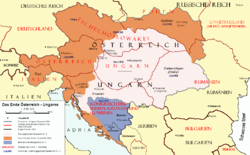
The following successor states were formed (entirely or in part) from the former Habsburg lands:
- Austria
- Hungary
- Czechoslovakia
- State of Slovenes, Croats and Serbs (joined with the Kingdom of Serbia on 1 December 1918 to form the Kingdom of Serbs, Croats and Slovenes, later Yugoslavia)
- Poland
Some Austro-Hungarian lands were also ceded to Romania, Ukraine and Italy. Liechtenstein, which had formerly looked to Vienna for protection, formed a customs and defence union with Switzerland, and adopted the Swiss currency instead of the Austrian. In April 1919 Vorarlberg, the westernmost province of Austria, voted by a large majority to join Switzerland; however both the Swiss and the Allies disregarded this result.
Territorial legacy
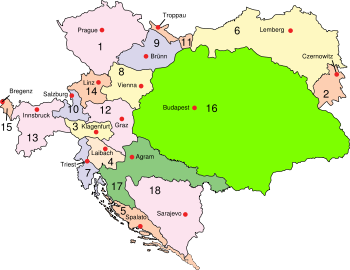 Kingdoms and countries of Austria–Hungary: Cisleithania: 1. Bohemia, 2. Bukovina, 3. Carinthia, 4. Carniola, 5. Dalmatia, 6. Galicia, 7. Küstenland, 8. Lower Austria, 9. Moravia, 10. Salzburg, 11. Silesia, 12. Styria, 13. Tirol, 14. Upper Austria, 15. Vorarlberg; Transleithania: 16. Kingdom of Hungary, 17. Croatia-Slavonia; Austrian-Hungarian Condominium: 18. Bosnia and Herzegovina |
The following countries were located within the boundaries of Austria-Hungary when the empire was dissolved:
Empire of Austria (Cisleithania)
- Austria (with the exception of Burgenland)
- Czech Republic (with the exception of Hlučínsko Area)
- Slovenia (with the exception of Prekmurje)
- Italy (autonomous regions of Trentino-Alto Adige/Südtirol and small portions of Friuli-Venezia Giulia)
- Croatia (Dalmatia, Istria)
- Poland (voivodeships of Lesser Poland, Subcarpathia, Silesia with the exception of the area of Katowice)
- Ukraine (oblasts of Lviv, Ivano-Frankivsk, and Ternopil, and most of the oblast of Chernivtsi)
- Romania (county of Suceava)
- Montenegro (bay of Boka Kotorska, the coast and the immediate hinterland around cities of Budva, Petrovac and Sutomore)
Kingdom of Hungary (Transleithania)
- Hungary
- Slovakia
- Austria ( Burgenland)
- Slovenia ( Prekmurje)
- Croatia ( Slavonia, Central Croatia, southern parts of the pre-1918 Baranya and Zala counties - today's Croatian part of Baranja and Međimurje county - )
- Ukraine (oblast of Zakarpattia)
- Romania (region of Transylvania and Partium)
- Serbia (autonomous province of Vojvodina, large parts of the Belgrade region)
- Bosnia and Herzegovina (the villages of Zavalje, Mali skočaj and Veliki skočaj incl. the immediate surrounding area western of the city of Bihać)
Austrian-Hungarian Condominium
- Bosnia and Herzegovina
- Montenegro ( Sutorina - western part of the Municipality of Herceg-Novi between present borders with Croatia (SW) and Bosnia and Herzegovina (NW), Adriatic coast (E) and the township of Igalo (NE))
- Raška region of Serbia and Montenegro under effective Austro-Hungarian occupation while formally part of the Ottoman Empire until 1912
Other parts of Europe had been part of the Habsburg-monarchy once but left it even before its dissolution in 1918. Prominent examples are the regions of Lombardia and Veneto in Italy, most of Belgium and Serbia and parts of northern Switzerland and south-western Germany.




